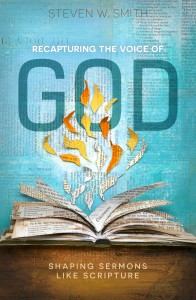It’s possible to be tied to the biblical text in your preaching and yet miss the voice and tone of the text, the specific shape of the genre God employed to get His message across. If you’re like me, you have a rhythm and method for sermon preparation and, at times, that method can start dictating how you preach rather than the text itself.
Steven Smith’s new book, Recapturing the Voice of God: Shaping Sermons Like Scripture is a lifeline for preachers who want to grow in their ability to preach the various genres of Scripture effectively. It rescues “biblical exposition” from becoming merely a style, and it shows how to substantively engage the way God delivered His message — not just what He said, but how He said it. This is a resource I will consult frequently.
I’ve asked Steven to join me on the blog for a conversation about how to shape our sermons like Scripture. Dr. Smith is the vice president of Student Services and Communications and professor of Preaching at Southwestern Baptist Theological Seminary.
Trevin Wax: Steven, your book opens with a concern that “expository preaching” has become a referent for “a tired, formulaic preaching template,” a style of structuring sermons that leads pastors to preach according to their template rather than preach the text. What has caused this problem? And why is it harmful?
Steven Smith: The root of the problem, in me at least, is that I begin to fall in love with sermons more than falling in love the Word. So now, exposition means using a certain template, or sounding like a certain preacher, no matter if we are actually dealing with the text or not. We start to think of preaching as representing a template instead of re-presenting Scripture.
Of course, not everyone does this, but it happens a lot. And then pastors and their congregations get tired of the template and turn to other avenues to fill that vacuum. My prayer is that those who are looking for another way to structure sermons will look to the structures that are embedded in the text. It’s not the next thing, it’s the first thing.
Trevin Wax: You want preachers to allow the text “to breathe” – to let the shape of the text drive the shape of the sermon. Why is it important for preachers to pay attention to the voice God uses in each genre?
Steven Smith: The principle reason to look at genre is that there is meaning at the structural level of the text. Secondly, this is the way that God chose to reveal Himself, so that means something. Thirdly, when I let the text shape the sermon, I never have to scramble for sermon structure again. It is all there provided for me. This accomplishes another goal of teaching people how to read Scripture.
Trevin Wax: Many pastors today speak of themselves as “communicators” instead of “preachers.” You say we are communicators, but we are more. What differentiates preaching from mere communication?
Steven Smith: The word “communicator” is fine as far as it goes. Certainly we want to do no less! But we are much more. We are speaking for God. We want to help people, and encourage people, but all of those goals are secondary to the goal of re-presenting what God has already said in His word. That’s a huge responsibility, and I fear that aspect of preaching in a pastoral context is played down today. We do not invent, we relay what He has already said.
Trevin Wax: Some pastors may hear your counsel to vary up their style based on the genre of text and say, I feel tired just thinking about it! How can I master preaching from all the Bible’s genres? But you’ve categorized all the genres into three main buckets: story, poem, letter.
Which one is hardest for you to preach? And how have you grown in your ability to preach that type of Scripture well?
Steven Smith: Poetry, no question. Stories have a structure that emerges clearly after reading, and epistles are usually pretty linear in their logic. So I really enjoy preaching narrative/parables, and epistles. But Hebrew poetry, including the prophets, does not reveal its structure easily to me.
The answer to how to grow more is that I need to preach them more. That’s the only way to get better. While I am disappointed on one level, it’s hard to describe how wonderful that is to think that there are massive portions of Scripture I do not know how to preach! What a joy! The rest of my life I get to explore these texts. Nothing better than that!
Trevin Wax: In reading through your chapters on specific genres, I see that some of your sermon outlines still follow a basic three or four point outline, but you refer to the points as “scenes” (for stories) or “moves” (for poem) rather than “points” (as in letters). How can a pastor implement your suggestions here without simply falling into the same, tired patterns of sermon structure?
Steven Smith: Well, the idea is to let the text be the text — whether it has scenes, points, or moves. What you call them is not all that important. The real difference is what we say when we preach. And, I am not sure that comes out in the written samples.
For example in the sermon in Revelation 19, I do not say when preaching it, “Now that we have seen this, let’s look at this point.” A point is actually a word picture for pointing to something. While my written document may have that structure in it, that’s not what I would say. The written document is just for my clarity. So the real difference is how it is preached.
Trevin Wax: There may be different genres of Scripture, but they all point us to Jesus – albeit in different ways. What counsel would you give to the preacher who wants to be “Christ-centered,” but finds that his way of pointing to Jesus each week begins to sound the same?
Steven Smith: Great question.
I think we need a good and honest discussion of what it means to be Christ-centered in our preaching. Or, more specifically, assuming we are talking about a pastoral context, we need to answer the question of what is a pastor’s goal in Christ centered preaching.
If it is to mention the gospel in each sermon that is a wonderful goal, and something I try to do each time I preach. It seems that a more ambitious, and helpful, goal would be to equip people with a macro level understanding of the exaltation of Christ through the salvation of His people through all of Scripture. If that is the long term goal, then I think preaching is sometimes clearing a spot and making the gospel as explicit as possible.
At other times it is showing a nuanced link to a covenant that is ultimately fulfilled in Christ. Sometimes we are sketch artists, sometimes we are impressionist. But the goal is that over time people can make the connections in the text.



















